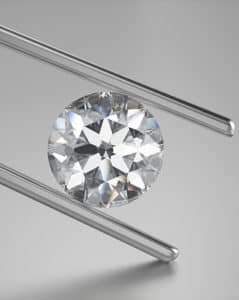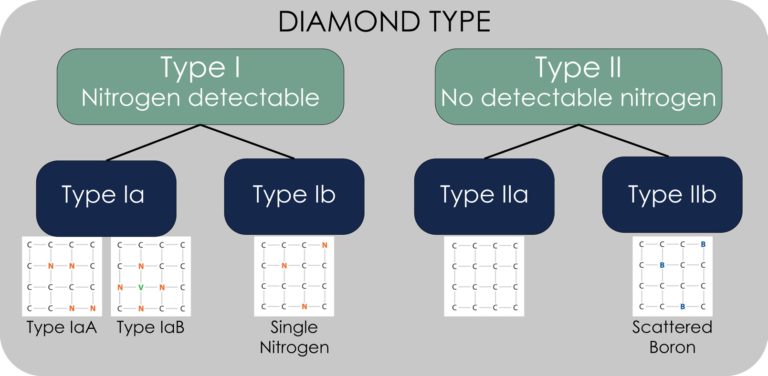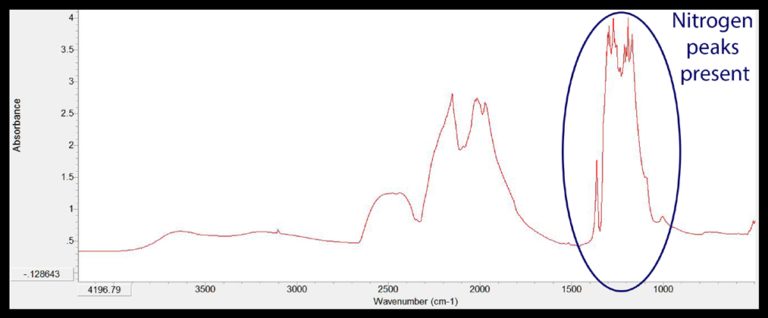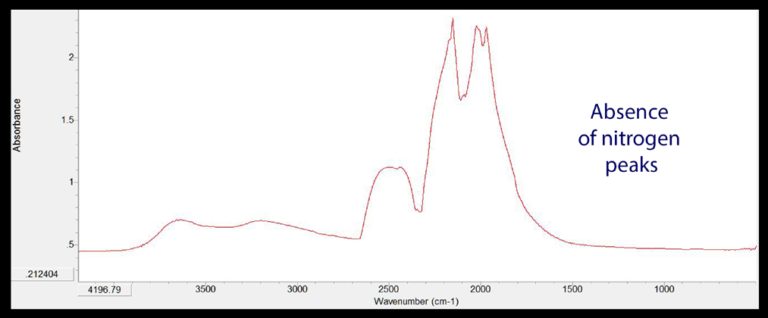The classification system of diamonds, its importance, and laboratory testing processes.
By Wade Abel, CG, Director of Gemological Services, AGS Laboratories
You may have heard of diamond type; however, you may not know how important this classification system is and how it is used at AGS Laboratories. People may speak about diamond type in reference to rarity, which it can indicate. However, there are other important reasons for knowing the type of a diamond, especially when it comes to identification and detection of some very important factors.
What is diamond type?
Diamonds are classified according to their chemical makeup. We know that diamond is made up of carbon, however other trace elements are typically present in the crystal structure. The arrangement, and relative amount of those elements, are used to define and determine diamond type.
The most common element besides carbon for colorless diamonds is nitrogen. Over time, with heat and pressure, nitrogen atoms in the crystal structure of a diamond can come together to form groups called aggregates. Nitrogen aggregates in diamond can be in groups of two, three, or four. Nitrogen can also be present as single atoms scattered throughout the crystal structure. Most diamond typing is based on the presence or absence of nitrogen and the different aggregations. The other element that is used for diamond type determination is boron.

Diamonds are separated into two overall types, Type I and Type II. Generally speaking, Type I diamonds have nitrogen present in the crystal structure, whereas Type II diamonds have no detectible nitrogen in the crystal structure. Both types are further divided into categories based on either the aggregation of the nitrogen, or in the case of Type II, the presence of boron.
Here is a breakdown:
- Type I
- Type Ia – Nitrogen present with aggregations of two and four nitrogen atoms
- Type Ib – Nitrogen present, however only single nitrogen atoms without aggregation
- Type II
- Type IIa – No nitrogen detectable
- Type IIb – No nitrogen detectable, boron present

The Type Ia category is broken down further to indicate the different nitrogen aggregations, however those details are too extensive for the scope of this article.
Why is diamond type important?
Specific diamond types can indicate that a diamond could be laboratory grown or if it may have been subjected to permanent color enhancement, namely high pressure high temperature (HPHT) treatment. Knowledge of the diamond type is highly important when making the decision whether or not further advanced testing is required to determine these factors.
Certain Type I diamonds (with specific nitrogen aggregations) and Type II diamonds can be HPHT treated to improve their color. When these types are identified, further testing is required to ensure the correct determinations are made and disclosures are not missed.
Type II diamonds can occur naturally (comprising only about 2% of mined diamonds) or could be laboratory grown. Also, diamonds determined to be Type Ib (with single nitrogen atoms in the crystal structure) can be either natural or laboratory grown. If a diamond is determined to be Type II, or Ib, it is an indicator that further testing is required.
It is very important to report any treatment on a diamond report. Additionally, reporting the natural or laboratory grown origin of a diamond is a requirement, not only to comply with FTC standards, but to also uphold the AGS mission of consumer protection.
How does AGS Laboratories test diamonds?
One of the first processes in the lab is an initial screening of the diamonds to determine if further testing is required. The instruments we use give a “heads-up” if the diamond lends itself to HPHT color enhancement or of laboratory grown origin. These instruments have limitations however, and do not give us specific, important, type determinations. When a diamond is referred for further testing after the initial screening, Fourier Transform Infrared (FTIR) spectroscopy is used to identify the diamond type. FTIR spectroscopy sends an infrared beam through the diamond which absorbs some of the infrared light. What remains after this absorption is detected and is represented with a graph (spectrum) of the atomic makeup of the diamond. (FTIR Spectroscopy Basics, n.d.) The spectrum is interpreted by the detection team who look for specific peaks in the spectra that can indicate the diamond type. (See figure 1 & 2) Full interpretation of FTIR spectra requires extensive training.


If the diamond is determined to be a type that can be improved with HPHT treatment, or could be of laboratory-grown origin based on the FTIR analysis, additional testing is required. This is completed using multiple instruments. The tests reveal key diagnostic markers that identify natural or laboratory-grown origin, and evidence that either supports natural color or shows evidence of color treatment.
Normally, diagnostic spectral peaks and results from the additional advanced testing are present that lead to a conclusive determination.
Although diamond type is a very technical and scientific classification system of diamonds, understanding the importance of type determination, and what is done in the lab to promote full disclosure, provides insight into the steps taken to ensure that the appropriate information is gathered and disclosed.
Reference:
FTIR Spectroscopy Basics | Thermo Fisher Scientific – NL. (n.d.). Thermo Fisher Scientific. Retrieved February 9, 2021, from https://www.thermofisher.com/nl/en/home/industrial/spectroscopy-elemental-isotope-analysis/spectroscopy-elemental-isotope-analysis-learning-center/molecular-spectroscopy-information/ftir-information/ftir- basics.html